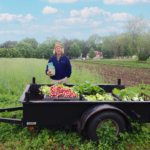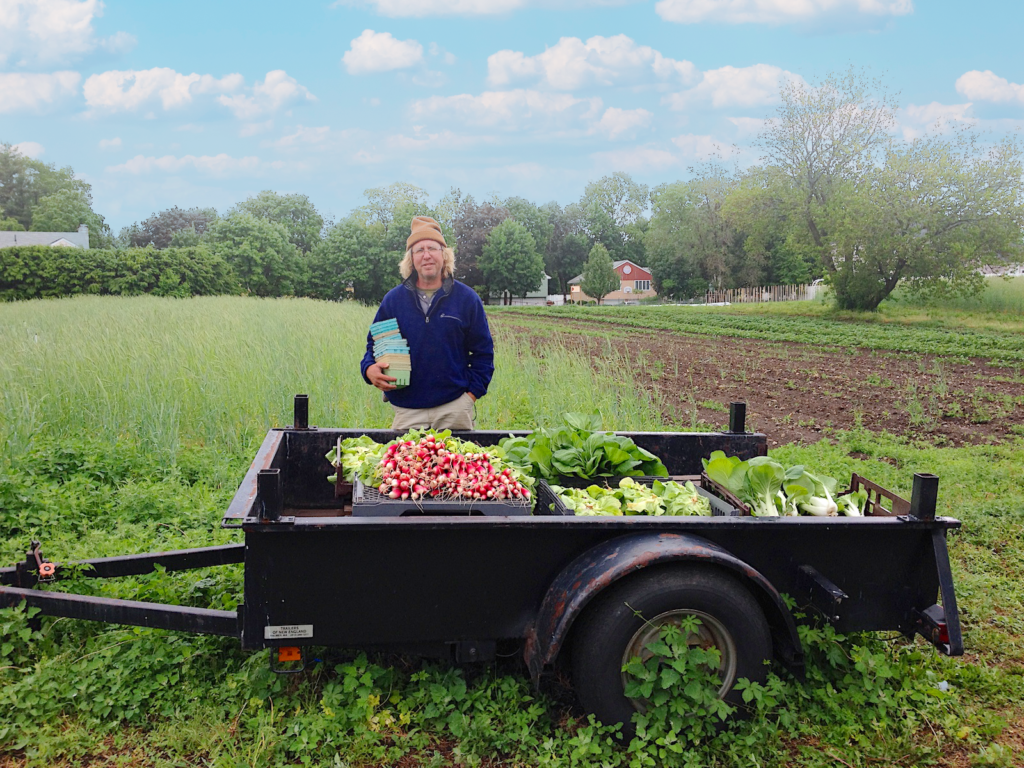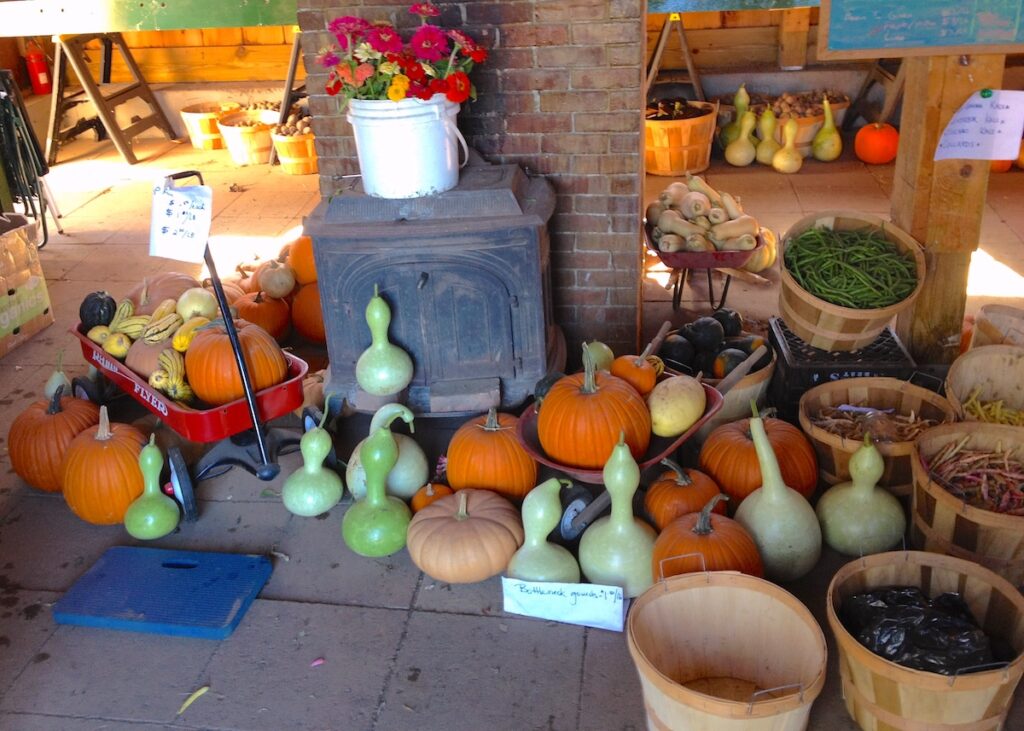
By Judith Feinleib
Henry Ogilby thinks of himself, his siblings, and Mike and Hermik Chase as stewards of the last remaining farmland in Belmont, part of the Richardson Farm Historical District. They are stewards in the classical sense of the term—people whose code of ethics requires them to engage in responsible planning and management of resources.
In this case, these resources are the land and houses that have been in the Ogilby family since the 17th century. For the last 11 years, the Chases have cultivated the land of Belmont Acres Farm where they grow and sell vegetables and keep sheep, goats, chickens, and ducks.
Both the Ogilby land and the structures on it are protected from development. That is due to the efforts of the late Lydia Phippen Ogilby, Henry’s mother, who many think of as Belmont’s last grande dame. Lydia Ogilby lived adjacent to the farmland in the yellow Thomas Richardson house on the corner of Washington, Blanchard, and Grove Streets. She was concerned that the future might see developers take over the land and use it for something other than farming. Accordingly, she sought ways to protect it. She found a way in the form of an Agricultural Preservation Restriction (APR). Creating the APR required the approval of the Select Board, Town Meeting, and the state legislature.
An APR sequesters land for agricultural use in perpetuity. In 2003, this 10-acre parcel of land was placed in an APR held by both the Belmont Land Trust, a local group, and the American Farmland Trust, a national organization. Though the Ogilbys own the land, its use is overseen by the two trust organizations.
Some years later, perhaps motivated by the possibility that the historic Thomas Clark House might be destroyed, Lydia Ogilby became concerned about the preservation of the Joseph Bright and the Thomas Richardson houses which were built by brothers-in-law who were Ogilby ancestors. The houses, located at 306 and 336 Washington Street, were not a part of the 10-acre APR.
In 2012, working with the Belmont Historic District Commission (HDC), Ogilby began the process needed to have the entire area—the 10 acres of farmland plus the two houses—become the Richardson Farm Historic District. The Select Board and Town Meeting approved this historic district in 2013. The effort was fortuitous; another comparable historic home, the Thomas Clark House, was demolished in 2014.
While the Ogilbys still own the land and houses, the American Farmland Trust and the Belmont Trust guarantee that the 10 acres of farmland will be permanently devoted to agriculture, and the HDC makes sure that all the structures in the Richardson Historic District will forever retain their character. The family pays agricultural property taxes on the farmland and residential property taxes on the Bright and Richardson houses. To Henry Ogilby, responsible stewardship includes responsibilities to the town.
Mike and Hermik Chase, Belmont residents, have worked Belmont Acres Farm since 2012. Their daughter Narineh, a senior at Belmont High School, has assisted them since they began to run the farm and oversees the weekly farmstand sales.
Mike Chase sees his interest in farming as part of his heritage. His family—great grandparents, grandparents, and parents—have all done serious gardening. He began helping when what is now Belmont Acres Farms was still Sergi Farms, and in 2011, he and Hermik began to farm a small portion of the land. When Henry Ogilby needed farming help because the Sergi brothers wanted to retire, the two began serious talks about having Mike and Hermik take over the entire farm.
Belmont Acres Farm at 34 Glenn Road, (www.belmontacresfarm.com), is a small operation with a large variety of produce. Seedling growth begins during the winter. New crops are tested every year. The farm opens in late spring and can stay open until there is a hard frost; some years, crops have been available until Christmastime.
The farm also has sheep, goats, ducks and chickens, and a border collie named Mei, who Mike Chase says, “ . . . moves the sheep from the barn to the pasture, puts the chickens into the coop in the evening, and keeps deer, Canada geese, coyotes, and turkeys out of the farm.” While Belmont’s school children visit to learn about the animals, the primary purpose of the animals is fertilizing the land. Fields are fertilized on a rotating schedule; fields where the animals graze lie fallow that year.
Because Belmont Acres Farm is a small, typically rocky-soil New England farm, profitability is problematic. The Chases have jobs that supplement their farming. Mike Chase has a PhD in environmental biology and has a second job as a bioinformatician at Harvard’s T. H. Chan School of Public Health. Hermik Chase has a master’s in public health and works for the Massachusetts Department of Public Health. Most staffers have worked at the farm for years and have second jobs. Still, they consider Belmont Acres to be their primary focus.
Mike Chase’s years of working on the farm have honed his views on farming and demonstrate how committed he is to preserving the land. Despite all the complexities involved in running Belmont Acres Farm, he believes that small farms are the key to healthy eating because the produce does not have to be transported. That means that it is as fresh as it can possibly be. At the same time small local farms provide much-needed green space in increasingly built-up areas. And while overcoming the challenges of working a classic New England farm is an ongoing effort, small farms can become profitable as improvements are made.
Through their maintenance of the Richardson Farm Historic District and their work on Belmont Acres Farm, the Ogilbys and the Chases demonstrate what it means to protect green space and historic buildings, and they are committed to doing so on a continuing basis. Their approach is diametrically opposed to those organizations—most notably wealthy private schools and some religious institutions—which decline to contribute to (and even undermine) Belmont’s welfare. In an age where so many seek to evade their obligations, the Ogilbys and the Chases are sterling examples of civic, fiscal, and environmental responsibility, and a credit to the town of Belmont.
Judith Feinleib writes If I May, (www.jfeinleibifimay.com), a blog on issues affecting Belmont. A Precinct 6 Town Meeting member, she has a doctorate in political science and, as an independent consultant, helps people with social media posting, writing, and in-house and external corporate communications.




Sorry, the comment form is closed at this time.